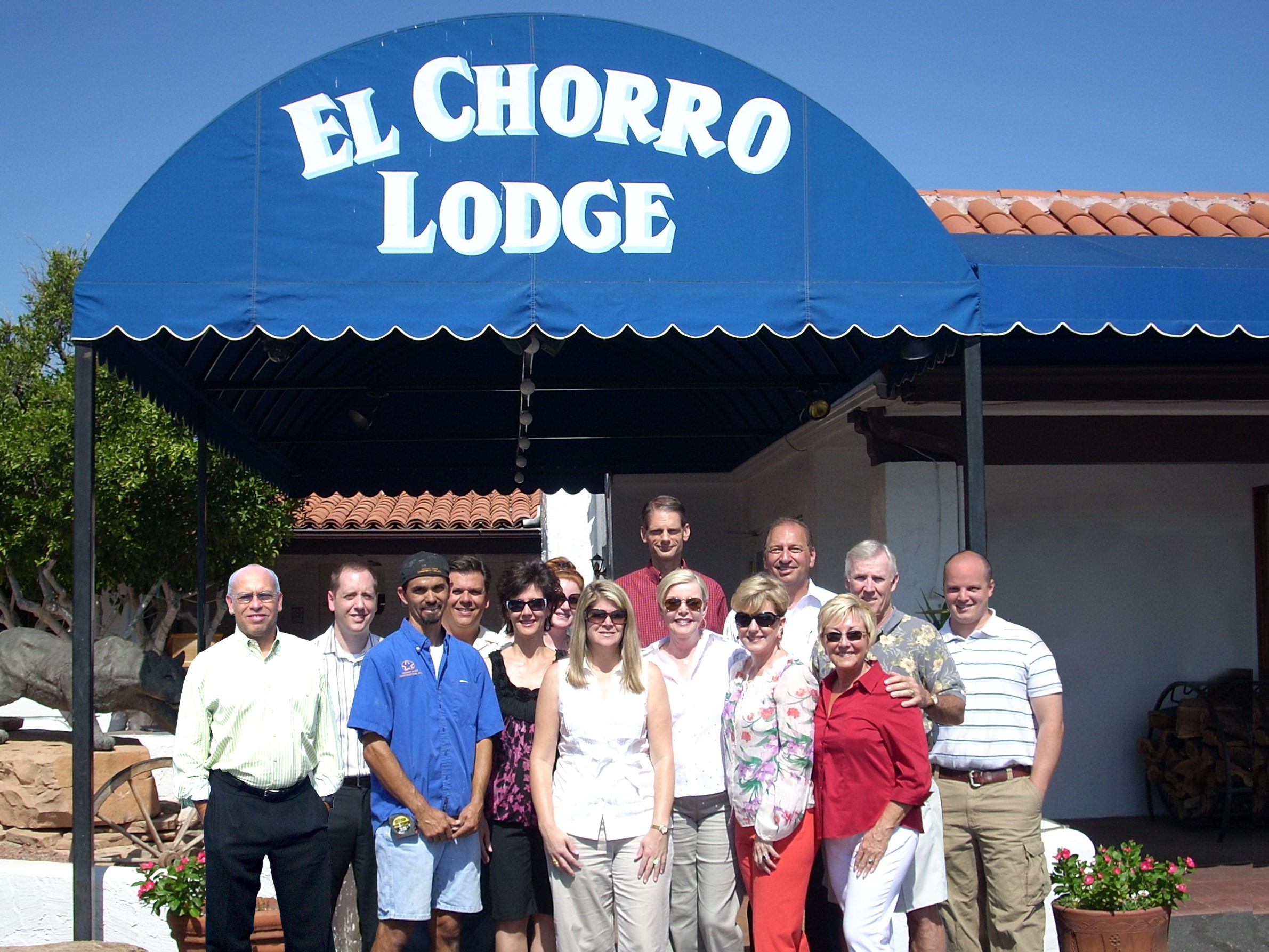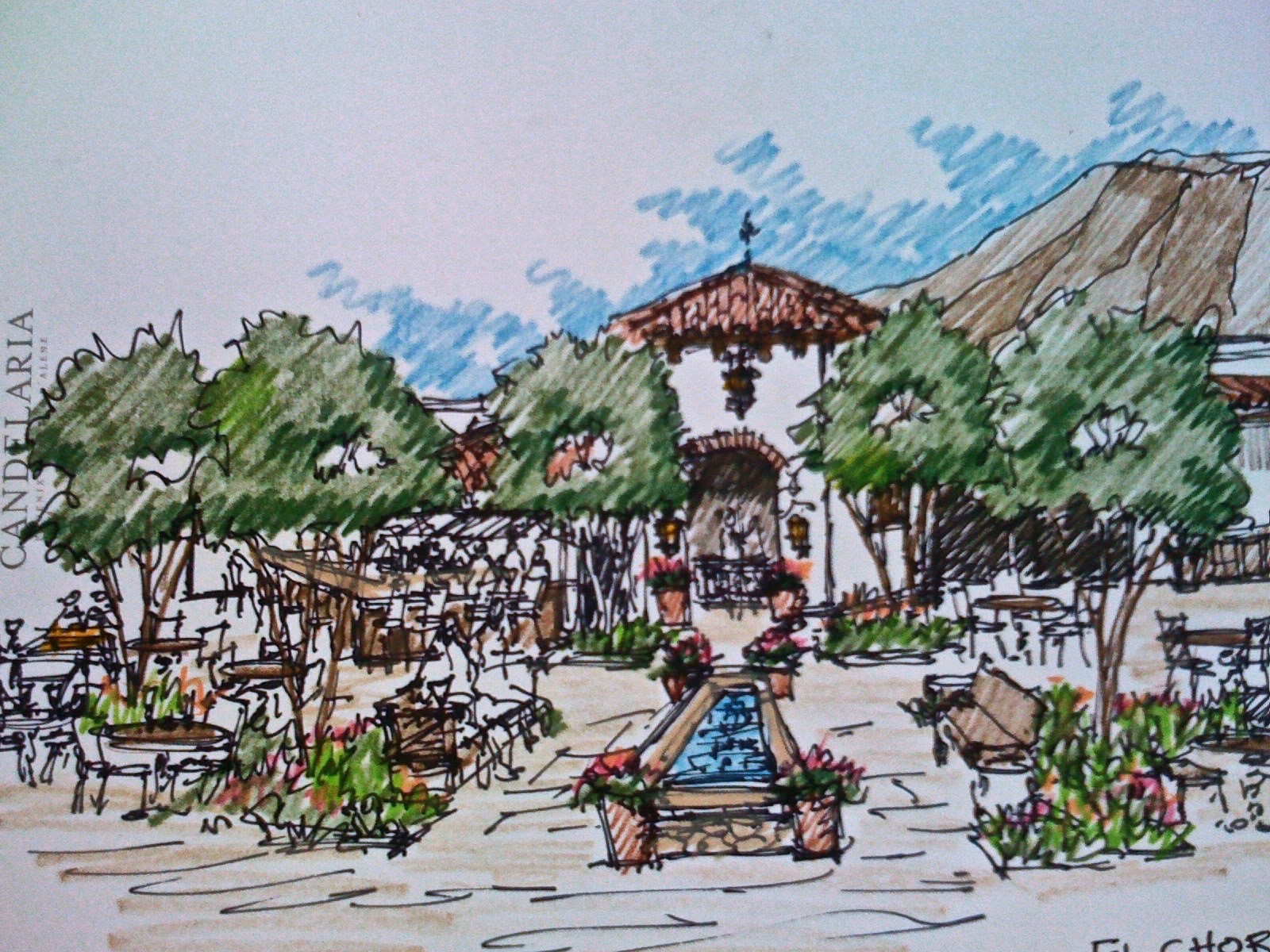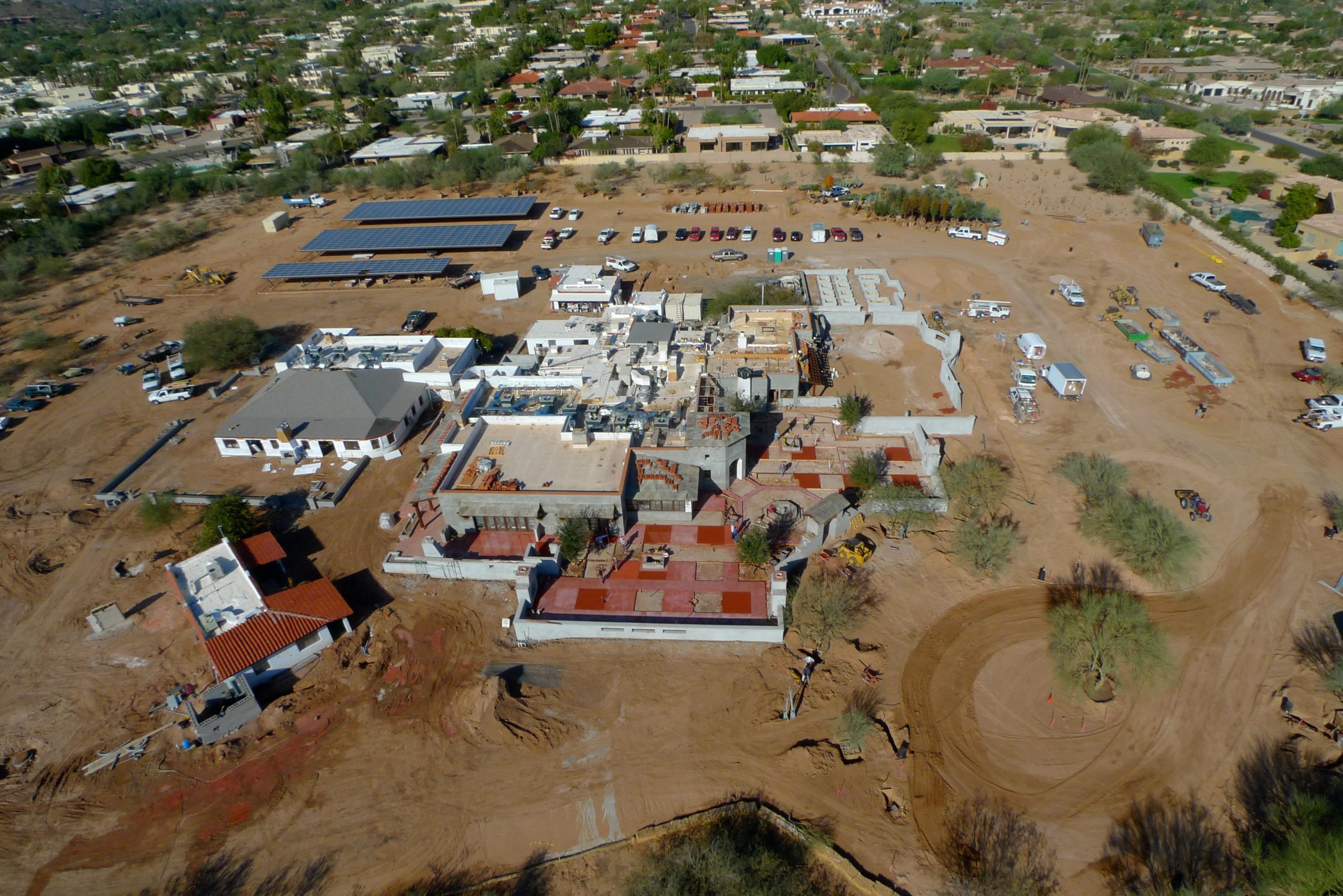More than eight decades of history are served at El Chorro Lodge, as well as great beverages and food –– especially those legendary house-made sticky buns. Following a full renovation 12 years ago, the Paradise Valley dining and event landmark is serving the future, too, as the state’s first full-service restaurant to attain the U.S. Green Building Council’s Leadership in Environmental and Energy Design (LEED) Gold Certification.
As the Great Recession peaked in 2009, longtime Paradise Valley resident and philanthropist Jacquie Dorrance purchased the historic 11-acre property to ensure the continuing legacy of one of the town’s few historically significant commercial properties. She was joined in the venture by operating partners Kristy and Tim Moore.
Offering breakfast, brunch and dinner, the restaurant and event destination is sited on the north side of Paradise Valley’s most famous street, Lincoln Drive, between its most well-known landmarks, Camelback and Mummy Mountains. El Chorro, now with 4,800 square feet of dining and bar space and 7,500 square feet of patio areas, annually hosts 150-plus special events and 90 weddings and greets more than 10,000 guests. It offers dinner Wednesday through Sunday evenings, as well as Sunday brunch.
A distinguished design and construction group completed the sustainably focused restoration in 2009: architect Mark Candelaria, AIA (CDA); green builders Jerry and Jeremy Meek, Desert Star Construction (DSC); Jeff Berghoff, principal of landscape architect Berghoff Design Group; Walter Spitz, Creative Designs in Lighting; interior designer, Donna Vallone, ASID; and Green Ideas principal, Mark Wilhelm. Dorrance says, “You have to know this was a dream team, which realized a multi-faceted renovation project with an aggressive timeline and a very big vision.”

In late July 2021, she sold the property to Phoenix-based Grossman Company Properties, a real estate and hospitality development and management company with six decades of Arizona experience. Dorrance explains that she chose the company so that when the historic El Chorro Lodge is eventually developed –– the land is super premium –– the resulting campus would celebrate the property and the character of Paradise Valley. The location includes many of Phoenix area’s finest homes and resorts, such as the Camelback Inn which is a mile or so west on Lincoln Drive, and Mountain Shadows, which is just across the street.
“We were pleased to have been able to work with Jacquie Dorrance on this purchase and are proud to have the opportunity to preserve and enhance El Chorro,” says Grossman Company Properties’ Matt Crow, a Paradise Valley resident for more than 30 years. The company owns and operates two properties in metro Phoenix, one in Flagstaff and several boutique hotels throughout southern and central California. In the 1990s, Grossman upgraded the world-famous Frank Lloyd Wright-inspired Arizona Biltmore Resort and Spa in Phoenix.
“It was important to me to ensure that El Chorro is preserved for future generations and stewarded by owners who understand its importance to Paradise Valley,” Dorrance says. “This was an opportunity to pass on the El Chorro tradition to a great company that will ensure it is a part of the community for decades to come.”
Eighty-Plus Years of Paradise Valley History
In 1934, inventor, entrepreneur, philanthropist and 1924 presidential candidate John C. Lincoln opened the original building as the Judson School for Girls so his daughter Lillian could attend school. Minnesotans Mark and Jan Gruber bought the property in 1937, transforming it into a restaurant and bar and adding lodging casitas. For the ensuing decades, it was known as El Chorro Lodge.
This was about a year after Jack Stewart, with Lincoln’s backing, opened the Camelback Inn on December 15, 1936. At the time, the hotel didn’t allow alcohol service, so, during the six months that El Chorro Lodge was open each winter, the site became a “watering hole” (“el chorro” in Peruvian Spanish) for guests on the way to dinner at the Camelback Inn.
Through Jan’s connections, El Chorro’s reputation grew, especially with movie celebrities such as Milton Berle, John Wayne (and later his sons), Jack Benny, John Ireland and Clark Gable, who visited as restaurant or overnight guests, explained Joe Miller in a February 1, 1999, interview with Ann Andeen and Ann Townsend. David Wright, son of Frank Lloyd Wright, was also a frequent guest in the 1950s during and after the construction of his famous nearby home. Miller and wife Evie purchased the property in 1973.
The Grubers had wealth and a rich history. Jan’s dad was a guide in the “Custer’s Last Stand” detail. “When Custer split his troops, he was with the ones that lived. He was the first one to discover the slaughter of Custer’s troops,” Miller explained. He added that Mark became the first superintendent at Glacier National Park and that one of their lake neighbors and a friend was the distinguished artist and sculptor, Charles Russell.
Miller started working at the Camelback Inn in the winter of 1952 and, through a contact, began at El Chorro as a day bartender, moving up to night bartender. He had grown up in the family restaurant business in Seattle, starting out by washing pots and pans when he was 10. His future wife Evie became a cocktail waitress at the restaurant in 1954.
After purchasing the property, the couple expanded the restaurant, employed about 18, including the chef, who worked three meals daily. The Millers expanded the restaurant capacity from 70 to 200 and opened it year round in 1990 instead of closing in the summer and early fall. Jan died in 1973, and Mark continued living on property until his death in 1975.
El Chorro Lodge Luxury Homes?
When the Millers were in the process of selling the property, many residents and local companies were concerned about its historical status and a possible rezoning to luxury housing. For the first, El Chorro Lodge is not protected by inclusion on the Arizona or National Historic Registers. In addition, would an out-of-area developer, less sensitive to the El Chorro history and place in PV history, ask the town to re-zone so that the company could subdivide the property into one-acre-or-more home lots?
“The town of Paradise Valley has no commercial zoning; it’s a residential town that allows commercial uses, such as the Camelback Inn and other resorts, to build with special use permits, which have lots of stipulations associated with the property, including noise, density and hours of operation,” explains Jeffrey G. Kramer, consulting registered architect for Candelaria Design and the firm’s project manager for the renovation.
“When I purchased El Chorro from Joe Miller, I assured him I would honor the legacy of El Chorro,” Dorrance says. “However, the main reason at the time was not only to preserve and improve upon that legacy, but I also felt that if we didn’t save it, the property would probably be developed into another gated community, which we did not need.”
However: “El Chorro is considered a landmark of Paradise Valley, but it is time to take advantage of the large property it sits on and to take it to yet the next level of excellence, and it is time to turn the page,” she adds. “The Grossman team is the right one to do this.”
“I believe that people see a visit to El Chorro to be more than just a meal, happy hour or event; it’s an experience at an iconic place that engages all of your senses through everything that surrounds you there,” Kramer says. “Jacquie’s purchase of El Chorro with the intent to restore, refurbish and revitalize was in many ways a saving gesture to the property and for the generations of patrons that loved El Chorro and wanted to see it live on.”
Sensitively restoring El Chorro was just one project aim. “A major goal of renovating the entire property was bringing more drama into the historic location,” explains Candelaria, one of the Southwest’s premier luxury residential architects. “We also wanted to offer guests a more open transition from inside to the outside, so we created an in/out bar and a 3,000-square-foot patio to enjoy the great views of Mummy Mountain on the south. We also added a dramatic welcoming entry courtyard with a central fountain, offering great views toward Camelback Mountain.”

Kramer adds, “The original dining spaces were often segmented into smaller rooms, often containing carpet, with very little continuity or connection to the exterior.” He notes that numerous sets of bi-folding wood French door panels throughout the property now provide this seamless connection, and bar windows open fully to allow for exterior service. We wanted to take the essence of what was special and weave it into modernized and expanded surroundings.”
Among the many changes in the “New Old El Chorro Lodge,” as Meek recalls the project requiring twenty-seven building permits and eight special use permits; ordering all new doors and windows prior to starting demolition to meet schedule; a firepit; and private dining spaces replacing the original bedrooms. In addition, the former bocce ball lawn became one of two wedding lawns; CDA associate and team member, Tim Mathewson, was married there. Spitz even put heaters into the umbrellas for winter comfort.
Candelaria notes that during design and construction from May 2009 to mid-February 2010, the Great Recession was stalling the local economy in all development niches, so the entire team, architect through subcontractors, highly appreciated the work: “It was a rough time which sent a lot of people eagerly into the renovation story of El Chorro.”
A Green Light all the Way for Renovation
Meek suggested that the renovation be as environmentally sensitive as possible. “When we were approached by Jacquie, she said she wanted to build a sustainable restaurant using local vendors and organic foods,” recalls Meek, who founded DSC in 1978. “After giving this some thought and researching the cost and schedule impact, we asked her what she thought about not only having a sustainable restaurant but also a sustainable building. Without hesitation, she said ‘yes.’”
He explains that the objective was not to add a “green band-aid” but to think holistically. “We incorporated into the renovation mechanical and environmental systems, while maintaining the original history, architecture and traditions that turned El Chorro into an icon in America,” he says.
“Our mission was to retain the classic ambiance and charm, while providing enhancements that exceed modern energy and operational standards, and in a very short period of time,” he says. “Another one of the main objectives was to be an example to the community: We can preserve properties without tearing them down.”
DSC encountered numerous issues. For instance, while completing the salvage and demolition of the original Classroom Bar, they found that the floor had been tiled. “When we discovered the green-colored concrete, we contacted Jacquie, and she approved restoring it to the natural materials and retaining the original lighting,” Meek recalls.
Inventorying the salvage materials as well as ordering long-lead materials was also challenging, especially with an aggressive schedule, he adds.
Among the salvaged items were the adobe walls; beams from the old lodge; and the clay roof tiles, which were all reinstalled in the new structure. In addition, the project donated 5,000-plus square feet of the pavilion roof tent fabric to Habitat for Humanity for its collection center to protect workers from the intense summer desert sunlight.
More than 75 percent of the construction waste was saved from landfills, such as the 840 pairs of recycled blue jeans, which became wall insulation. “We took the pants off of 840 people!”
His crew also uncovered electrical, gas and plumbing lines that were not built per code, requiring additional work to bring the renovated building into compliance. The roof and below-grade plumbing also required significant repairs and upgrades.
Regulations, permits and working with the town also intensified the demands of the tight schedule. “We were at the Town of Paradise Valley almost daily,” he recalls.
Officials were supportive but firm. “El Chorro embodies the essence of Paradise Valley. The greatest concern was to make sure the Dorrances would keep the original character of El Chorro, save a part of the original building and maximize the views, which they did,” recalls Vernon B. Parker, mayor at the time. He notes that during his first visit to Arizona to meet his girlfriend, later his wife, they stopped at El Chorro. “We gazed at the stars, and I pronounced to her that I wanted to spend the rest of my life here in Arizona,” he recalls.
He adds, “And our town planners did an amazing job in acting as a de facto historical society by insisting that certain design elements be implemented. We worked with then Town Manager Jim Bacon and Council to cut through a great deal of ‘red tape.’”
Other green elements were many technological updates including LED lighting, a solar panel for hot water and solar heating and covered parking in the back of the property. The parking and drive areas were topped with decomposed granite to reduce the heat island effect. Xeriscaping was also used to reduce water usage.
Low-emission products improved indoor air quality by preventing and reducing off-gassing. And the team minimized airborne contaminants created during construction by keeping the building envelope clean, sealing mechanical equipment and duct work, and flushing out the building prior to occupancy.
The emphasis on passive, climate-based design strategies was critical –– and difficult while preserving historic elements on a site, Meek explains.
Receiving a LEED certification meant a better building and much-improved efficiencies. “We achieved a higher degree of occupant comfort and control by bringing in more outside air and filtering it better for greatly improved indoor environmental quality. We have better light levels and still we managed to lower the overall energy consumption substantially compared to the old building,” he explains.
“An effective energy monitoring and visualization system tracks air-conditioning, lighting and solar PV production separately, allowing the owners to adjust, tune or correct systems in the building,” Meek said. “Once we measure, we can then improve.”
Preserving the Future

Classic Hotels is committed to preserving the character and charm of El Chorro Lodge, whatever future development might take place.
“At this time, we only plan on making subtle improvements to the El Chorro experience during the next couple of years but otherwise plan to operate the property as it exists today for dining, weddings and events,” says John Grossman, a longtime Valley resident and CEO of Grossman Company Properties.
“Our approach to hospitality investment is to honor the history and legacy of a property while making it a successful and sustainable business, with an eye toward long-term stewardship,” he adds. “Our plan with El Chorro is to take this approach and celebrate the property’s heritage while enhancing it for a new generation of patrons, in step with the unique character of Paradise Valley.”
For more information on the green renovation, visit DSC.CO/ElChorroStats andelchorro.com.
Brown is an Arizona-based freelancer (azwriter.com).
Keep up with all of Green Living’s original content online and on social media.





